Are you ready to dive into the fascinating world of fish with big eyes? Prepare to be amazed as we introduce you to 15 impressive aquatic creatures that will make you do a double take! From the dragon-eyed beauty of the Telescope Goldfish to the starry-eyed swimmer, the Celestial Goldfish, these fish are sure to captivate your imagination. Whether they are masters of the murky depths, speedy predators, or acrobatic feeders, these fish have one thing in common – their big, mesmerizing eyes. Get ready to embark on an underwater adventure like no other as we explore the intriguing world of these eye-catching creatures. So, grab your snorkel and let’s dive right in!
Telescope Goldfish: The Dragon-Eyed Beauty
The Telescope Goldfish, also affectionately called the “dragon eyes” or “black moor” depending on its color, is a captivating sight in home aquariums worldwide. It’s a variety of fancy goldfish, but what makes it truly unique is its distinctive, protruding eyes, which have earned it a place among the list of impressive fish with big eyes.
These charming creatures are known for their active and playful personalities, making them a delightful addition to any aquarium. But it’s not just their vivacious spirit that makes them stand out. Feeding them can become an engaging spectacle.
“The Telescope Goldfish’s diet is pretty standard, consisting of small insects, crustaceans, and plant matter. However, their large eyes result in relatively poor eyesight due to the positioning, making feeding a challenge in a tank with faster, more aggressive fish.”
Despite the challenge, observing these dragon-eyed beauties navigate their way around their aquatic home, hunting for their food, is a truly intriguing sight.
| Scientific Name | Common Names | Distinctive Feature | Diet |
|---|---|---|---|
| Carassius auratus | Telescope Goldfish, Dragon Eyes, Black Moor | Protruding eyes | Small insects, crustaceans, plant matter |
Next on our list of impressive fish with big eyes is the Bigeye Fish, a master of the murky depths. Just like our telescope goldfish, these creatures have a distinctive gaze. But unlike the playful goldfish, the Bigeye Fish is a creature of the deep, known for its survival strategies. Stay tuned to dive deeper into the fascinating world of these aquatic wonders.
Bigeye Fish: Unraveling the Secrets of the Murky Depths
Meet the Bigeye Fish, a family of marine species that has fascinatingly adapted to the mysteries of the deep. These creatures are a testament to the phrase “beauty is in the eye of the beholder,” with their unusually large eyes being their most striking feature. These enormous peepers aren’t just for show – they serve a critical survival purpose. In the gloomy depths where sunlight is a luxury, their large eyes capture every possible photon of light, enabling them to navigate and spot prey with ease.
Often cloaked in a vibrant hue of bright red or shiny silver, the Bigeye Fish is a sight to behold against the backdrop of coral reefs and rocky marine landscapes. These creatures are brilliant color-changers too. In a fascinating display of natural theatrics, they can shift their colors based on their mood, the time of day, or when confronted with threats. This remarkable ability not only helps them communicate but also serves as a survival strategy, camouflaging them from predators.
When the coral reefs go quiet and the world above sleeps, the Bigeye Fish spring into action. These nocturnal hunters use their large eyes to spot small fish and crustaceans, turning the dark ocean depths into their hunting ground.
“Did you know? The Bigeye Fish can change color based on their mood, time of day, or in response to threats.”
The Bigeye Fish, belonging to the family Priacanthidae, are found across the Atlantic, Indian, and Pacific Oceans. These masters of the murky depths are not just remarkable survivors, but also an essential part of our marine biodiversity. Their adaptation to deep-sea living reminds us of the wonders and mysteries the ocean depths hold.
So, next time you dive into the blue or visit an aquarium, remember to look out for these incredible fish with big eyes. Their story is a testament to the adaptability and resilience of life under the sea.
Horse-Eye Jack: The Social Swimmer with Piercing Gaze
The ocean is a kaleidoscope of fascinating creatures, and one such marvel is the Horse-Eye Jack. This species stands out in the crowd of underwater inhabitants, thanks to its large, reflective eyes, which mirror the brilliance of the aquatic world. Living in the vast expanses of the Atlantic Ocean, the Horse-Eye Jack uses its distinct eyes, which bear an uncanny resemblance to that of a horse, to spot and pursue its prey in the deep or murky water.
These fish are not just known for their striking eyes, but also for their vibrant bluish-gray or green skin that shimmers under the sun. They prefer to dwell near the surface, but they are also capable of exploring the deeper waters in their quest for food. In fact, their adaptability to both surface and deep-sea life adds to their uniqueness.
One of the most intriguing aspects of the Horse-Eye Jack is its social behavior. These fish are not the solitary kind; they believe in the power of community. You’ll often find them moving in large, coordinated schools, creating an awe-inspiring spectacle for divers and marine biologists. This social structure not only offers them protection from predators but also increases their hunting efficiency.
When it comes to their diet, Horse-Eye Jacks are not very picky; they feed on smaller fish and invertebrates. Their hunting strategy is simple – use their large eyes to locate their prey, move swiftly, and grab a quick meal!
Did you know? The Horse-Eye Jack’s name originates from its unusually large eyes, which resemble those of a horse. These reflective eyes are not just for show; they play a crucial role in their survival in the deep sea.
In the grand scheme of marine biodiversity, creatures like the Horse-Eye Jack are more than just anothees of fish. They exemplify nature’s ingenuity in adapting to diverse environments. Their large eyes, social nature, and versatile dietary habits are a testament to their resilience and adaptability, making them a truly noteworthy member of our list of impressive fish with big eyes.
Barracuda: The Speedy Predator
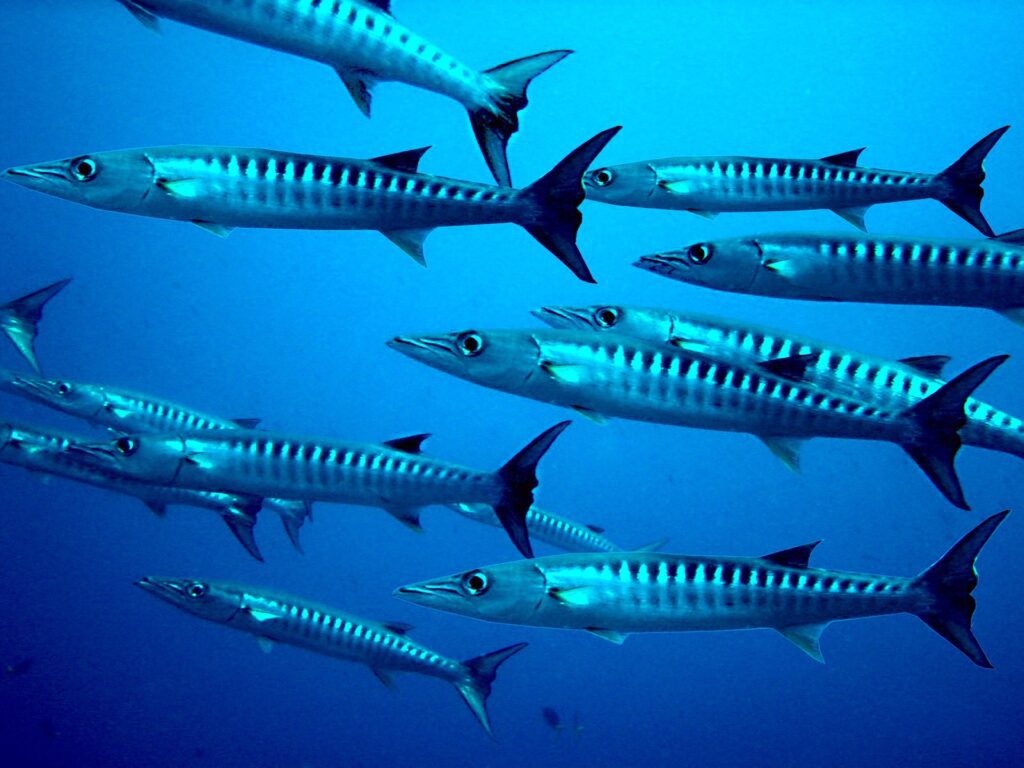
Barracuda
Imagine gliding through the tropical and subtropical oceans, your journey lit by the shimmering rays of the sun piercing through the azure waters. Suddenly, a swift silver flash captures your attention. You’ve just encountered the formidable Barracuda, a true marvel of the underwater world.
Barracudas, with their long, slender bodies sheathed in glistening silvery scales, are a sight to behold. These large predatory fish are like the silver bullets of the ocean, darting through the water at lightning speeds. Their two separate dorsal fins, a distinctive feature, ripple through the water as they maneuver with remarkable agility.
“From their fang-like teeth to their large eyes, every feature of the Barracuda is a testament to their predatory prowess.”
Barracuda’s mouths are a story in themselves. Their jaws, robust and powerful, are armed with sharp, fang-like teeth – an arsenal designed for a ruthless hunter. When their large eyes, which allow them to hunt with precision in both clear and murky waters, lock onto a target, there’s little hope for escape.
Read about: “Unveiling Mexico’s Majestic Emblem: Meet the Golden Eagle, the National Animal”
But the Barracuda’s most awe-inspiring attribute lies in its speed. Capable of reaching a staggering 27 miles per hour, Barracudas are among the fastest fish in the ocean. This speed, coupled with their predatory adaptations, makes them a force to be reckoned with in their underwater realm.
So, whether you’re a marine enthusiast, a diver, or simply an admirer of nature’s wonders, the speedy Barracuda serves as a remarkable testament to the adaptability and resilience of life beneath the waves.
Swordfish: The Fast Swimmer
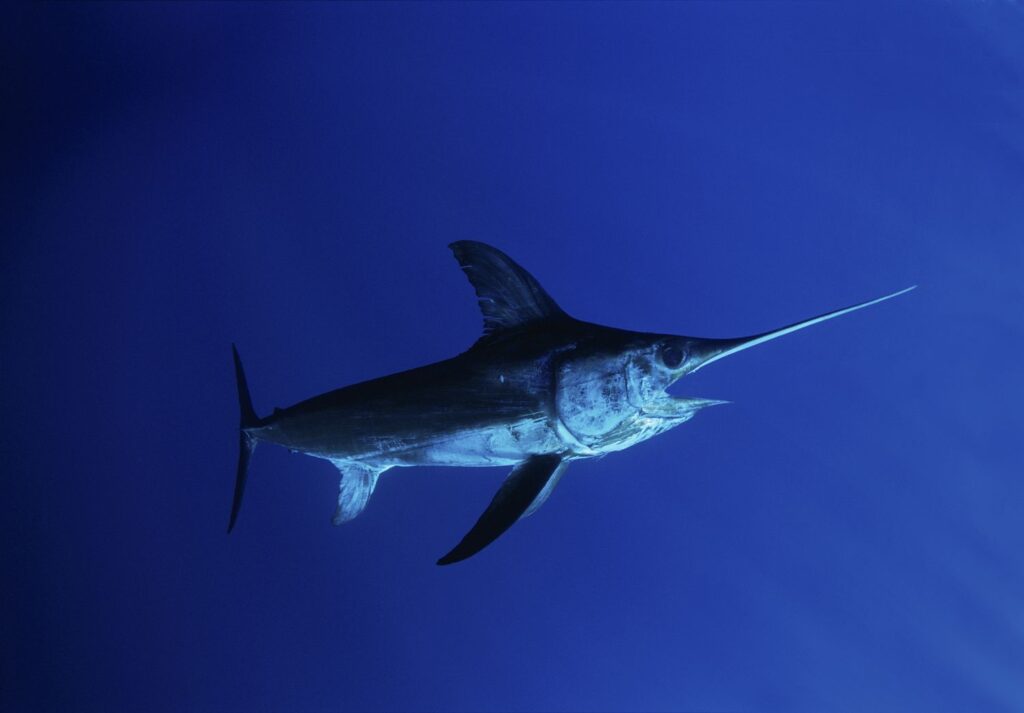
Swordfish
If the sea were a racetrack, the Swordfish, with its streamlined body and superior agility, would surely be the reigning champion. Akin to the Barracuda, the Swordfish, christened Xiphias gladius in the world of science, is a tour de force of the oceanic depths. But it doesn’t stop there. This majestic creature is also a resident of the vast expanses of the Atlantic, Indian, and Pacific Oceans.
Their most striking feature? Without a doubt, their large eyes, a testament to nature’s ingenious design. Just like the Horse-Eye Jack, these eyes are not just for show. They serve as the Swordfish’s headlights in the deep, dark corners of the sea, where light is a scarce commodity. This adaptation is crucial for a predator that relies heavily on visual cues to capture its quarry, which primarily comprises various types of fish and squids.
Did you know? Swordfish are among the fastest fish in the ocean, but popular culture often exaggerates their speed to be up to 60 mph (97 km/h). However, their actual speed, while still impressive, is a subject of ongoing research among marine biologists.
Despite their formidable size and the threatening sword-like bill extending from their snout, the Swordfish are not invincible. They, too, fall prey to the circle of life, becoming a meal for larger predators such as sharks and killer whales. This serves as a stark reminder of the delicate balance that governs life under the sea.
Next time you see a Swordfish, whether in a documentary or an aquarium, remember the incredible adaptability and resilience these fish exemplify. Their large eyes, incredible speed, and unique hunting adaptations are a testament to the marvels of our marine world.
Bigeye Tuna: The Deep Diver
In the aquatic world, where light is a prized commodity, the Bigeye Tuna (Thunnus obesus) has taken a unique approach to thrive in the darker, deeper realms of the ocean. Found in both the tropical and temperate waters of the Atlantic and Pacific Oceans, these robust swimmers boast considerably larger eyes compared to their tuna relatives.
“Their eyes, their most striking feature, are a testament to their evolutionary journey and their life in the ocean’s twilight zone.”
This adaptation is no mere coincidence. The larger eyes, akin to twin lanterns, are a result of their affinity for deeper, darker waters where sunlight struggles to penetrate. In these challenging conditions, the Bigeye Tuna’s enhanced ocular capabilities allow it to capture as much light as possible, turning the oceanic darkness into an ally rather than a hindrance.
Their large eyes aren’t just for show, though. These titans of the deep are also swift swimmers, their streamlined bodies cutting through the water with ease. Their diet is as diverse as the ocean itself, primarily consisting of other fish and squids. But what’s truly remarkable is their ability to dive. The Bigeye Tuna is not just a casual swimmer; it is a deep-sea explorer, capable of diving deeper than 500 meters in search of its prey.
| Scientific Name | Habitat | Diet | Unique Trait |
|---|---|---|---|
| Thunnus obesus | Tropical and temperate waters of the Atlantic and Pacific Oceans | Primarily fish and squids | Large eyes for better light capture in deeper, darker waters |
These fascinating fish, with their large eyes and deep-diving skills, exemplify the adaptability and resilience of marine life. They turn the challenges of their environment into strengths, making the most of what they have, and in doing so, they thrive in a world that remains largely unexplored by mankind.
Tarpon: The Acrobatic Feeder
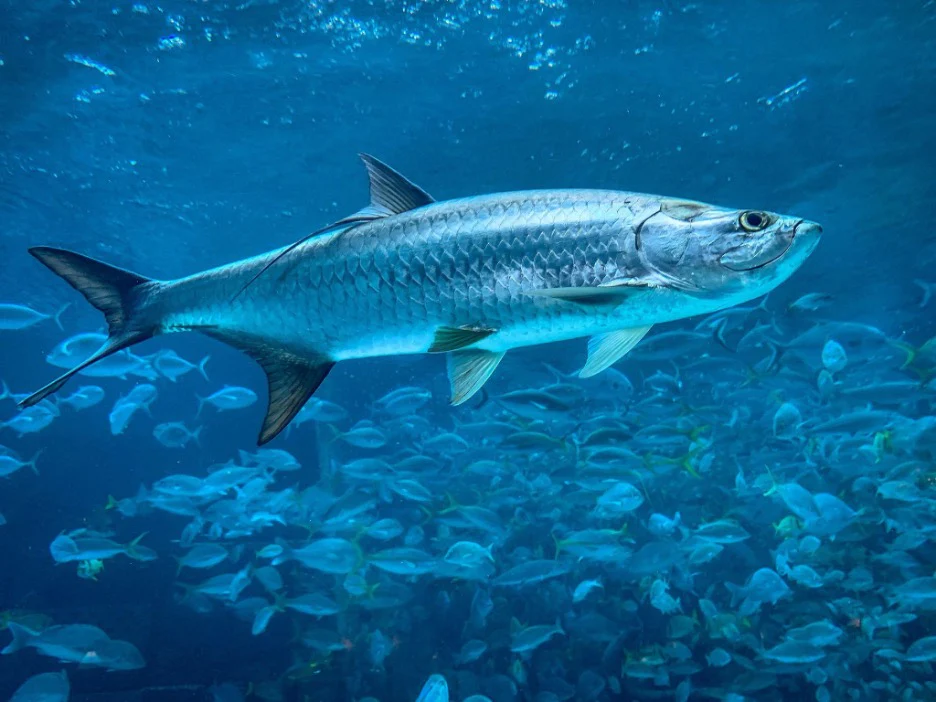
Tarpon
Imagine a fish that can leap out of the water, perform acrobatics mid-air, and still manage to escape the fisherman’s hook! This is no ordinary fish, but the Tarpon, scientifically known as Megalops atlanticus. With their awe-inspiring agility and strength, Tarpons have created a niche for themselves in the vast waters of the Atlantic Ocean.
Adorned with a suit of bright silver scales, they glimmer under the sun like a precious marine jewel. Their large, shiny eyes, a defining characteristic among the big-eyed fish, serve as powerful searchlights, scanning the waters for their next meal. Growing to impressive lengths of 4-8 feet, these giants are a spectacle to behold in their aquatic kingdom.
Did you know? Tarpons can gulp air and extract oxygen via a lung-like bladder when they are in hypoxic (low-oxygen) environments.
This breath-taking ability to breathe air in low-oxygen environments is what sets Tarpons apart from many other marine species. It’s a testament to their adaptability, resilience, and the sheer will to survive in challenging environments.
Being opportunistic feeders, Tarpons enjoy a varied diet. From small fish that swim unaware in their vicinity to the unsuspecting invertebrates tucked away in the ocean bed, nothing escapes the keen eyes and swift movements of the Tarpons. Their feeding habit is as much a survival tactic as it is a testament to their predatory prowess.
But what truly makes Tarpons the stars of the marine world is their acrobatic prowess. Once hooked, they put on a spectacular aerial display, leaping out of the water in a show of defiance. This display of strength and agility, combined with their brilliant silver scales shimmering in the sun, is a sight that leaves spectators spellbound.
From the depths of the Atlantic Ocean to the heart of the fishing community, the Tarpon’s tale is one of adaptability, survival, and sheer spectacle. Truly, they are the acrobatic feeders of the marine world.
Squirrel Fish: The Nocturnal Hunters of the Tropics
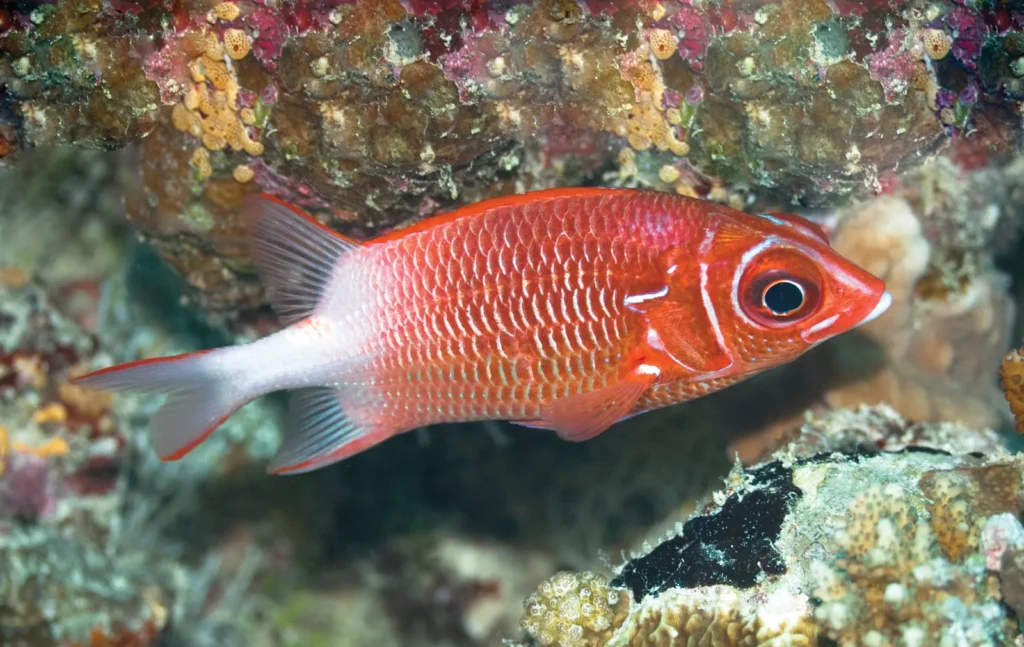
Squirrel Fish
Picture this: As the sun dips below the horizon, an array of small, vibrant fish emerge from the crevices of tropical reefs. Their large eyes shimmer in the moonlight, reflecting the glinting stars above. They belong to the family Holocentridae, better known as Squirrel Fish. These nocturnal hunters, equipped with their large eyes and distinctive spiny fins, are ready for a night of successful hunting in the Atlantic, Indian, and Pacific Oceans.
With a brilliant reddish hue, Squirrel Fish certainly make a splash in the underwater spectrum. Their vivid coloration is a sight to behold, but it’s not just their beauty that sets them apart. Squirrel Fish are known for their shyness. Approach one, and it will likely dart away, disappearing into a nearby crevice faster than you can blink.
Did you know? Squirrel Fish have a unique way of communicating with each other. They grind their teeth together to produce a chattering sound, a peculiar form of underwater dialogue!
Their behavior is quite intriguing. Squirrel Fish are predominantly nocturnal creatures, shying away from the sunlight and coming alive under the cloak of darkness. During the day, they take refuge in the crevices and shadows of the vibrant tropical waters. But when the night falls, they turn into skilled hunters, preying on small crustaceans and fish.
Read about: Aardvark vs. Anteater: What Sets Them Apart in Appearance, Habitat, Behavior, Diet, and Reproduction?
Squirrel Fish’s large eyes are not just for show; they serve a critical purpose. In the dim light of the ocean’s depths, their enhanced vision allows them to navigate with precision, tracking down their prey with unerring accuracy. This capability, much like the Bigeye Tuna’s proficiency in dark waters, is a testament to their adaptability and survival prowess.
In conclusion, whether it’s their striking appearance or their unique lifestyle, Squirrel Fish are truly an exciting chapter in the grand tale of big-eyed fish species. As we dive deeper into the world of these fascinating creatures, let’s keep our eyes wide open, for there’s plenty more to see and discover!
Spotted Ratfish: The Unique Chimaera Unveiled
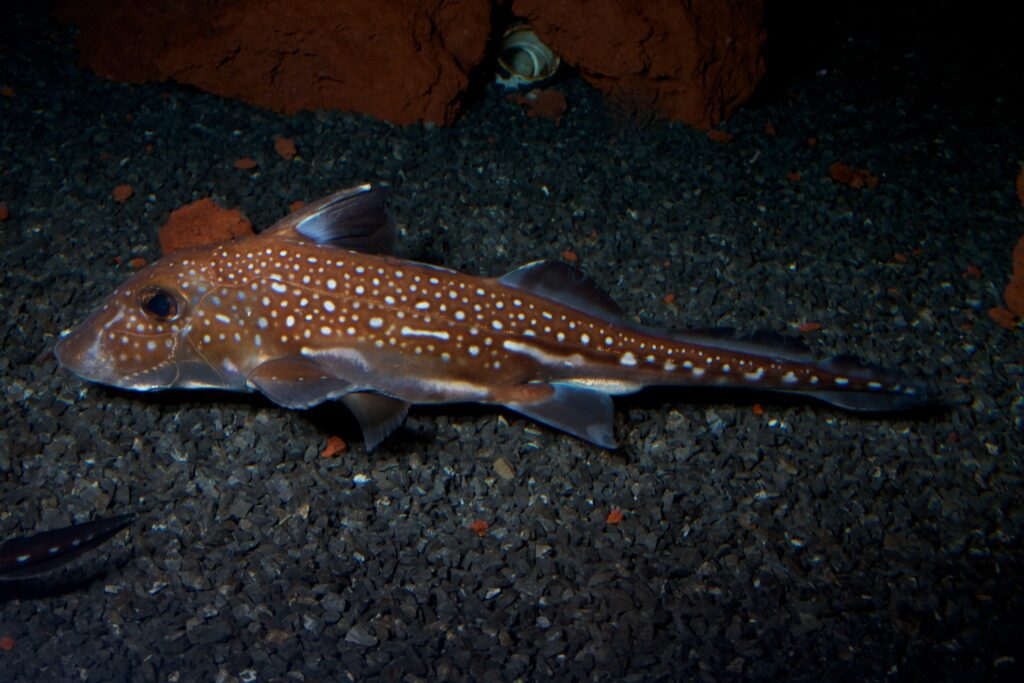
Spotted Ratfish
Just as the Tarpon captivates with its acrobatic feeding and the Squirrel Fish impresses with its nocturnal hunting, another fascinating creature emerges from the aquatic realm. Its name, the Spotted Ratfish, is as intriguing as its lifestyle. A member of the Chimaera species, this fish, with its striking characteristics, is an enigma waiting to be understood.
Part of the cartilaginous fish family, it shares its lineage with creatures as formidable as sharks and rays. Its unique moniker mirrors its anatomy – a tail reminiscent of a rat, and a body that’s a tribute to the sea’s diversity. But it’s the Spotted Ratfish’s large, greenish eyes that truly set it apart, painting a vivid picture of its adaptation to the deep-sea environment.
“The Spotted Ratfish’s eyes, glowing green in the dark, are like lighthouses guiding it through the inky depths of the ocean.”
These eyes, reminiscent of a cat’s in the dark, are its compass in the ocean’s abyss. They enable the Spotted Ratfish to navigate and locate its prey, small fish, and invertebrates, against the backdrop of the ocean floor. This fish, mostly found near the seafloor, is a testament to the remarkable adaptability and survival instincts of marine species.
However, the Spotted Ratfish hides another surprise. The males of the species sport a retractable sex organ on the forehead, a feature as unique as their rat-like tail. This peculiar adaptation adds another layer of intrigue to this species’ dynamic existence.
Just as the Tarpon’s aerial stunts and the Squirrel Fish’s nocturnal prowess highlight their distinctive lifestyles, the Spotted Ratfish’s unique adaptability contributes to the diverse tapestry of marine life. And as we continue to explore the ocean’s depths, we can’t help but marvel at the myriad adaptations these ‘big-eyed’ fishes have developed to thrive in their unique habitats.
So, join us on this fascinating journey as we uncover more about these impressive fish with big eyes, each with a unique story to tell.
Rockfish and Dogfish Sharks: The Long-Lived and the Pack Hunters
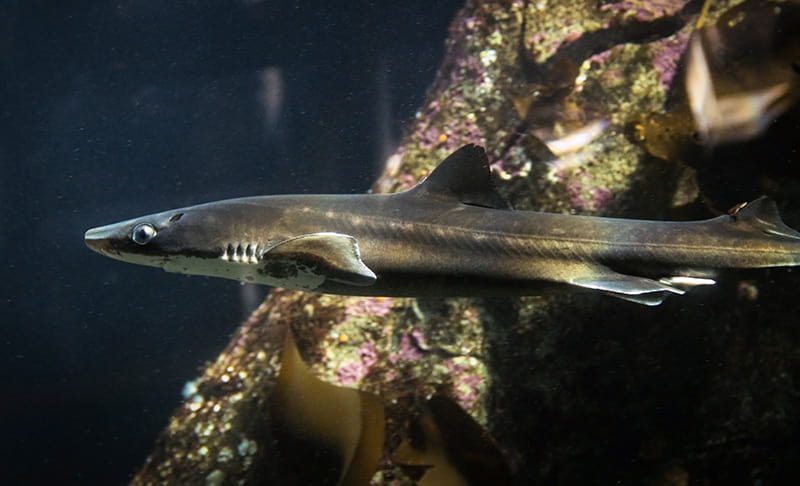
Dogfish Sharks
Delve deeper into the aquatic realm with the vivacious Rockfish and the intriguing Dogfish Sharks. These fascinating species, with their large, observant eyes, are the perfect embodiment of adaptation and survival, each unique in their lifestyles, and both contributing to the vast biodiversity of the marine world.
The Centenarian Rockfish
The Rockfish, with their large eyes reminiscent of lanterns illuminating their path, have a preference for rocky shorelines, a habitat where their keen sight serves them well. These rocky confines often present a murky, labyrinthine world, where the ability to navigate and hunt efficiently is paramount. Being viviparous, Rockfish are among the rare fish species that give birth to live young, further showcasing their unique adaptability.
Did you know? Some Rockfish species can astonishingly live for over a century, making them one of the longest-lived fish species on the planet.
Their longevity, combined with their rich, succulent meat, makes them a popular catch among anglers. Yet, it’s their big, expressive eyes that truly capture the essence of their survival, giving them an edge in their rocky, underwater realms.
The Pack-Hunting Dogfish Sharks
On the other end of the spectrum, we find the Dogfish Sharks, small but tenacious predators with large, reflective eyes that seem to glow in the obscurity of the ocean floor. These bottom-dwellers lead a diverse dietary life, feasting on a variety of prey ranging from fish to squid and crustaceans.
Fun fact: Dogfish sharks derive their name from their pack-hunting behavior, mirroring the hunting strategy of dogs on land.
Interestingly, most Dogfish species come equipped with venomous spines at the front of their dorsal fins—a formidable line of self-defense. Moreover, they are among the few fish species that exhibit a form of sleep, adding to their intriguing nature.
Whether it’s the longevity of the Rockfish or the pack-hunting strategy of the Dogfish Sharks, the world of big-eyed fish continues to astound with its diversity and adaptability. Stay tuned as we delve deeper into this captivating underwater universe.
Pufferfish: The Inflatable Toxic Ball
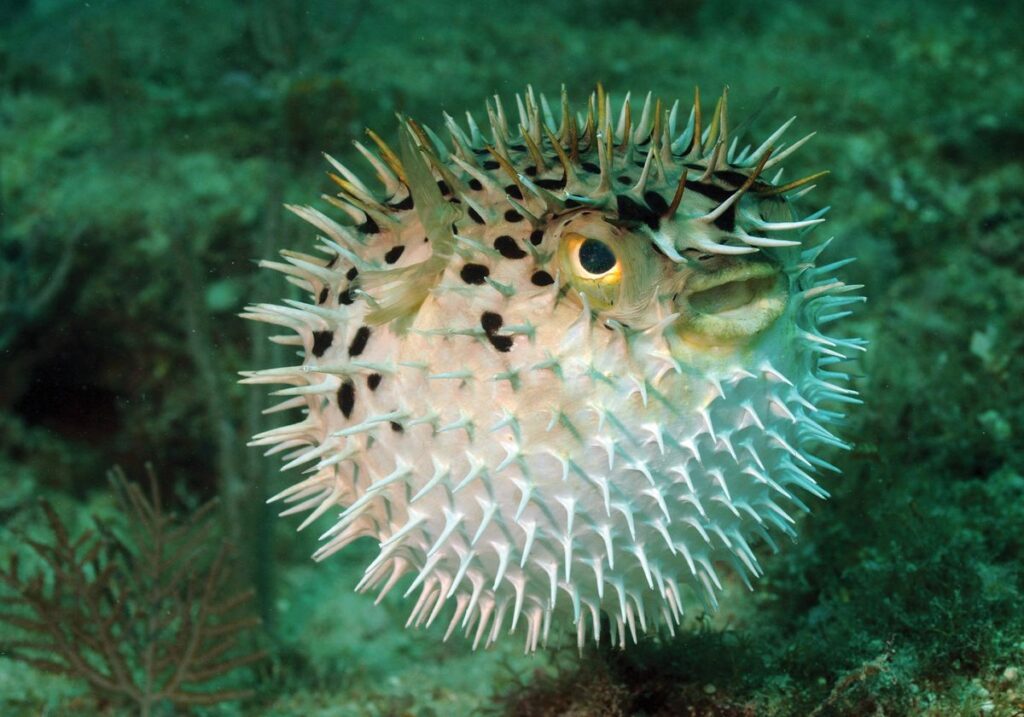
Pufferfish
Imagine floating in the warm, crystal-clear waters of a tropical ocean, when suddenly a small, brightly colored creature catches your eye. As you move closer, its large, expressive eyes meet yours, and in a split second, it transforms into a round ball, almost like a balloon. You, my friend, have just encountered a Pufferfish from the family Tetraodontidae.
These underwater creatures, found in abundance in tropical and subtropical oceans worldwide, are much more than meets the eye. The Pufferfish’s ability to inflate itself into a ball-like shape, almost doubling its size when threatened, is a sight to behold. This sudden transformation is their unique defense mechanism, aimed at surprising and deterring potential predators.
“Despite their endearing appearance, Pufferfish are among the most toxic creatures in the ocean, harboring a poison more deadly than cyanide.”
Their vibrant colors and patterns serve as a warning sign in the marine world, hinting at the deadly toxin they carry within. This toxin, known as tetrodotoxin, is a potent neurotoxin that is about 1200 times more poisonous than cyanide. In fact, eating a Pufferfish can be fatal if not prepared correctly. Despite this, it is considered a delicacy in some cultures, specifically in Japan where it is known as ‘Fugu’ and is prepared by highly trained chefs.
The large, expressive eyes of the Pufferfish not only add to their unique charm but also serve an important function. These big eyes help them spot potential threats and food sources in the vast expanse of the ocean, contributing greatly to their survival.
In the grand scheme of things, the Puffer fish, with its big eyes and unique survival tactics, serves as a reminder of the incredible diversity and adaptability of life under the sea.
Next, we move on to a creature known for its migratory prowess and sleek, blue body – the Blue Shark.
Blue Shark: The Long-Distance Migrant

Blue Shark
Dive into the deep blue with us as we explore the thrilling life of the Blue Shark, known scientifically as Prionace glauca. A creature of the world’s temperate and tropical oceans, the Blue Shark is a sight to behold in the vast underwater realm. Their slim, streamlined body, punctuated by a long, pointed snout and large, round eyes, is a testament to their excellent adaptation to life in the deep waters.
Their signature color, a vibrant deep indigo blue on top, gracefully transitions to a bright white underside, setting them apart from other marine species. This stunning color palette is not merely for show; it serves as a brilliant example of countershading, a natural form of camouflage. From below, their white belly blends with the bright surface water, while their dark blue back merges with the deep sea when viewed from above. This clever trick of nature aids the Blue Sharks in evading predators and in their hunt for prey.
Speaking of their diet, Blue Sharks are not fussy eaters. With a menu ranging from squid to birds and various species of fish, these creatures are versatile predators. Their large, round eyes provide excellent vision, crucial in the murky depths and during their nocturnal hunts.
Perhaps one of the most fascinating aspects of the Blue Shark’s life is their remarkable migratory behavior. These creatures undertake long, seasonal migrations, travelling vast distances in pursuit of cooler waters during the sweltering summer months. This behavior, akin to a grand summer vacation, represents one of the longest migrations known among fish.
So, there you have it – the Blue Shark, a long-distance migrant with a captivating life beneath the waves. As we continue our journey through the world of impressive fish with big eyes, let’s appreciate the diversity and adaptability that make marine life so incredibly fascinating.
Porbeagle Shark: The Deep-Diving Predator
Imagine dwelling in the cold and temperate marine waters of the North Atlantic and the Southern Hemisphere. There, you will encounter one of the ocean’s most intriguing creatures, the Porbeagle Shark, scientifically known as Lamna nasus. This creature captures your attention not only for its large eyes, reminiscent of the Pufferfish’s gaze, but also for its sleek, torpedo-like body akin to the Blue Shark’s form.
The Porbeagle Shark, a member of the mackerel shark family, is a testament to the adaptability and diversity of marine life. Like a submarine, it boasts a robust, streamlined body, a conical snout, and a crescent-shaped tail that propel it through its underwater world with grace and power. Its eyes, as large as the full moon on a clear night, allow it to spot bony fish and cephalopods, its preferred meals, even in the murkiness of the deep sea.
“Did you know? Porbeagles are one of the few shark species that can elevate their body temperature above the temperature of the surrounding water, an adaptation known as regional endothermy.”
This remarkable feature is what makes the Porbeagle Shark a deep-diving predator. It dives into the depths of the ocean, possibly in search of food. As it embarks on this journey, its body temperature rises above that of the surrounding water, a unique adaptation called regional endothermy. This ability not only aids in their hunting prowess but also underscores their resilience in the often harsh conditions of the ocean depths.
Just as the Blue Shark embarks on long migrations for cooler waters, and the Pufferfish inflates its body as a defense mechanism, the Porbeagle Shark too, showcases its own unique survival tactic. And it’s these big-eyed, deep-diving predators that continue to intrigue us with their adaptability and strength.
Stay tuned as we dive deeper into the world of large-eyed marine creatures. Up next, we’ll explore the starry-eyed swimmer of the aquatic world, the Celestial Goldfish.
Celestial Goldfish: The Starry-Eyed Swimmer
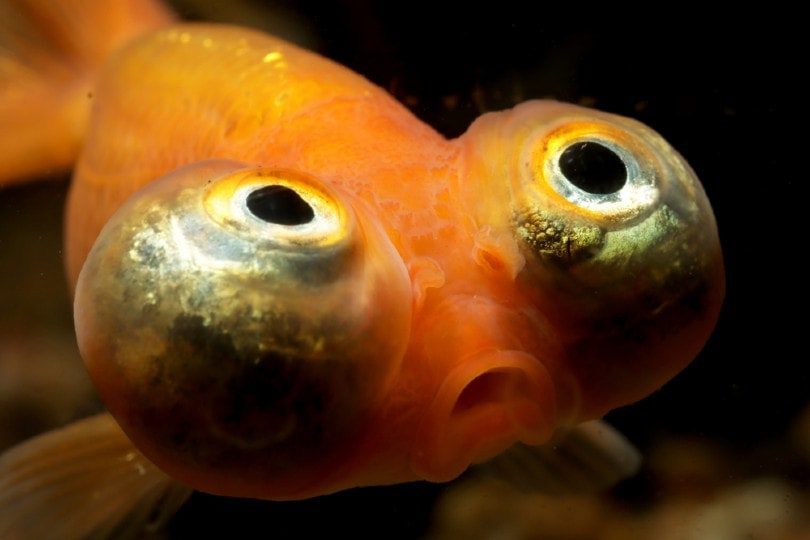
Celestial Goldfish
From the long-distance migrant Blue Shark to the deep-diving Porbeagle Shark, nature’s underwater tapestry is exceptionally diverse. Now, let’s turn our gaze from the vast, open oceans to the tranquil, serene beauty of domestic aquariums. Here, we encounter an entirely different spectacle of big-eyed marvels, one of which is the enchanting Celestial Goldfish.
The Celestial Goldfish, bearing the scientific name Carassius auratus, is a special member of the fish kingdom. Unlike many of its counterparts, this fish is not found in wild, open waters. Instead, it graces the peaceful environment of domestic aquariums around the globe, bringing joy and tranquility to the homes of countless aquarists.
This breed stands out with its unique and charming eye characteristics. The Celestial Goldfish’s eyes are large, bulging, and intriguingly directed upwards. This distinctive feature, akin to permanently gazing at the stars, has earned it the affectionate nickname of the “Starry-Eyed Swimmer”.
Despite the absence of a dorsal fin, this fancy goldfish navigates its watery home with a unique grace. It may not be the most agile or fast swimmer, but it thrives best in a calm, predator-free environment, making it a delightful sight in any peaceful aquarium setup.
“The Celestial Goldfish, a testament to nature’s creativity, is not just a fish. It is an aquatic piece of living art, a mesmerizing spectacle with eyes that seem to gaze into the cosmos.”
Interestingly, this breed’s peculiar eye position is no accident of nature but a result of selective breeding during the Tang Dynasty in China. This captivating fish, with its upward gaze, was carefully cultivated to bring a unique aesthetic appeal to domestic aquariums, a tradition that continues to this day.
Our journey through the world of big-eyed fish continues, each creature revealing its unique adaptations and survival strategies. From the majestic oceans to the tranquility of home aquariums, these creatures never cease to amaze us with their incredible diversity, beauty, and resilience.
A Journey Through the Eyes of the Aquatic World
Just like the starry-eyed Celestial Goldfish that graces our homes with its unique beauty, or the Porbeagle Shark that prowls the deep ocean with its thermoregulatory prowess, the creatures we have explored represent a fascinating panorama of big-eyed fish. Each one of them, in their own distinctive ways, has adapted to their environments and circumstances with one common trait – their impressively large eyes.
These big-eyed wonders show us that in the realm of nature, every feature, every adaptation has a purpose. Whether it’s to navigate the murky depths, to hunt in low light conditions, or to simply serve as a striking display, these magnificent eyes are far more than just a visual spectacle. They are a testament to the ingenious survival strategies of these aquatic marvels.
The Bigeye Tuna, for instance, with eyes larger than its tuna cousins, thrives in deeper, darker waters where its large eyes are crucial for capturing as much light as possible. It’s a classic example of how nature crafts its creatures for survival.
As we continue our exploration into this stunning world of big-eyed fish, it’s impossible not to be awed by the sheer diversity and adaptability of these creatures. From the speedy Barracuda to the acrobatic Tarpon, from the nocturnal Squirrel Fish to the unique Spotted Ratfish, each of these fish tells us a captivating story about life beneath the waves.
While the sheer size of their eyes can seem disproportionate or even comical, it’s a reminder of the extraordinary ways nature equips its creatures to thrive in their distinct environments. So, as we marvel at these fascinating fish, let’s remember that in the grand tapestry of life, every feature, no matter how bizarre or outlandish, has a purpose and contributes to the harmony of existence.
As we delve deeper into this underwater world of big-eyed swimmers, we invite you to stay tuned for more intriguing insights into the lives of these and other remarkable denizens of the deep. The journey is far from over, and there’s plenty more to discover in this wonderful world of animals.
Telescope Goldfish is a variety of fancy goldfish known for its distinctive, protruding eyes.
Telescope Goldfish are popular in home aquariums because of their unique look and active personalities.
Telescope Goldfish have a diet consisting of small insects, crustaceans, and plant matter.
No, Telescope Goldfish have relatively poor eyesight due to the positioning of their eyes.
Horse-Eye Jack is a game fish with large, reflective eyes that help them locate prey in deep or murky water.
Horse-Eye Jack got its name from its unusually large eyes resembling those of a horse.
Barracudas have two separate dorsal fins, a large mouth, and strong jaws equipped with sharp, fang-like teeth.
Barracudas use their large eyes to hunt with precision in both clear and murky waters.
Swordfish have streamlined bodies and large eyes, which are adaptations for hunting at depths where light is scarce.
Swordfish primarily feed on various types of fish and squids.
Bigeye Tuna have larger eyes as an adaptation to their preference for deeper, darker waters.
Large eyes are beneficial for Bigeye Tuna as they help capture as much light as possible in the deep, dark waters.
Tarpons have bright silver scales and large, shiny eyes.

